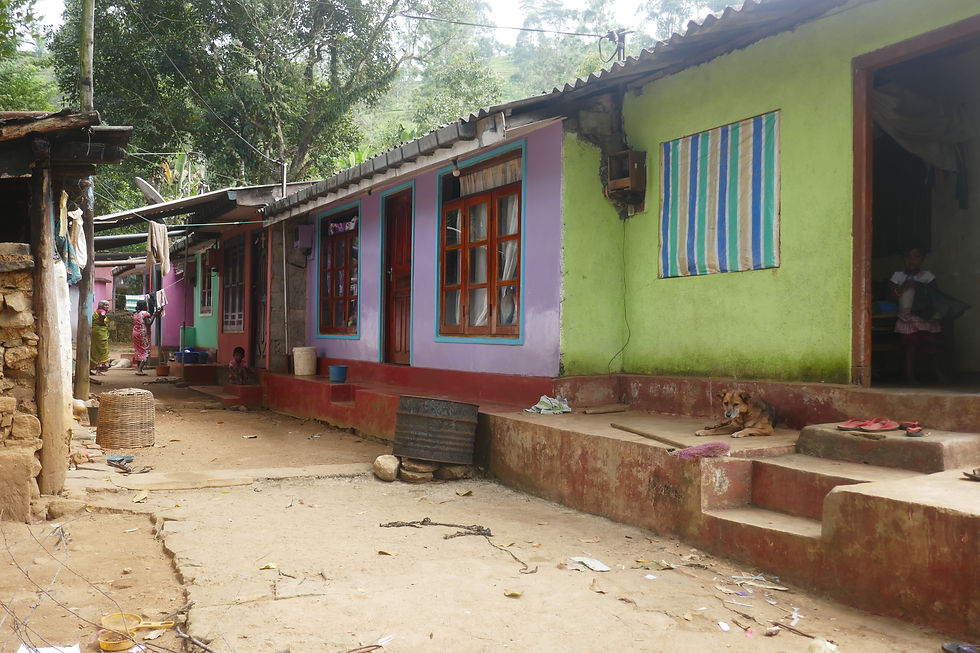The Reality of Tea Estates: Line Rooms
- Sascha Pare
- 21 déc. 2017
- 3 min de lecture
The poverty on tea estates is easily overlooked. There is so much to distract the eye, a shimmering waterfall here, a wave and a cry from across the road, rows of brightly painted little houses with the washing drying in the gleaming sunshine, and of course the sheer beauty of the lush, neatly planted tea bushes carpeting the rolling hills. But glimpse behind that line of orange and pink houses, follow the path up to where the tea pickers are hard at work, venture to the back streets of that bustling little town and an altogether bleaker picture will jump out at you.

Queensland, Bunyan estate, Maskeliya
Tea bushes haven’t always blanketed these hills, in fact they are a rather recent addition to the country’s selection of landscapes. Ceylon tea was introduced by the British when they colonised the island in the mid-nineteenth century and found up-country perfectly suited to its cultivation. Soon the tea industry was booming but Sinhalese workers refused to tie themselves to the routine work and there was a shortage of labour. Taking advantage of the extreme poverty and recurring famines gnawing at South India, the British began bringing Indian Tamils to the Sri Lankan hills, the majority of which they drew from the lowest caste group. Tea country became home to an oppressive system that imposed many restrictions on plantation workers, and alienated them from the Sinhalese population in every possible way.
The colonial planters allocated housing according to the Hindu caste system and the type of job a person carried out on the estate. From a distance, these colourful little homes with ornate window frames look like doll houses. Step into one, you will find families of nine living in a 19 square meter space, sharing an outside toilet with four other families. Shanmugapriya, a student at Tea Leaf Vision this year, invited me to stay with her for a night and only now do I grasp the utter lack of privacy and hardship of life in a line room.
Some uneven steps lead down from the road to a row of bright orange living quarters with a step leading into each of them. Inside, a young woman was crouching over a gas stove on the floor and a boy sat cross-legged on a plastic chair, watching a Tamil musical, the sound blaring out for all the neighbours to hear. I sat down on a foam-cushioned sofa and after a few seconds, little heads peered around the curtains and little hands drew them apart so everyone could catch a glimpse of me. Behind me was another room with no windows, a wardrobe and mattresses propped up against the wall. People started pouring into the room, Shanmugapriya’s nephew, her mother’s sister’s husband’s brother’s son, her auntie and two young girls who just wanted to get a better look at me. There was no table to place the carom board on so we balanced it on the armrests with the TV blasting the latest Vijay film in the background the whole time. For dinner we all sat on Shanmugapriya’s parents’ bed except her auntie who sat on a little wooden stool, and although I could tell there was only one egg to be shared and only a small portion of curry for each of us, they insisted I should eat more. I had to go to the toilet in the middle of the night and tried to sneak out of the room but Shanmugapriya was up in a flash and insisted on coming with me so we picked our way around the people sleeping on the floor. They don’t turn the lights off at night, I didn’t ask why. In the morning they put all the mattresses up against the wall again and folded up all the sheets and blankets, put another film on and her mother went off to pick her daily 18kg of leaves.
The line rooms are almost without exception owned by the companies that own the tea estates. Plantation workers have no official tenure rights, effectively binding them and their families to work in exchange for housing and guaranteeing a stable and docile workforce. It’s no wonder that social problems arise from such living conditions. Alcoholism, domestic violence, gender discrimination, suicide and self-harm, the list goes on and on.
Sascha





















Commentaires